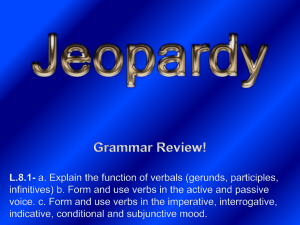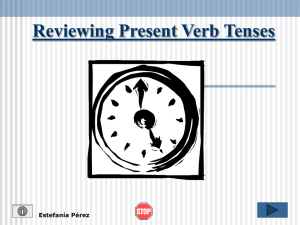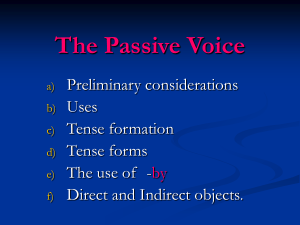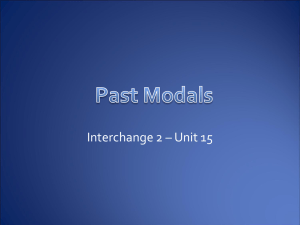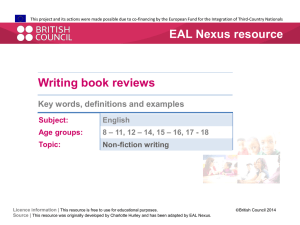LATIN 101/102 Study Guide Verb Conjugations/Tenses/Moods/Voices
advertisement
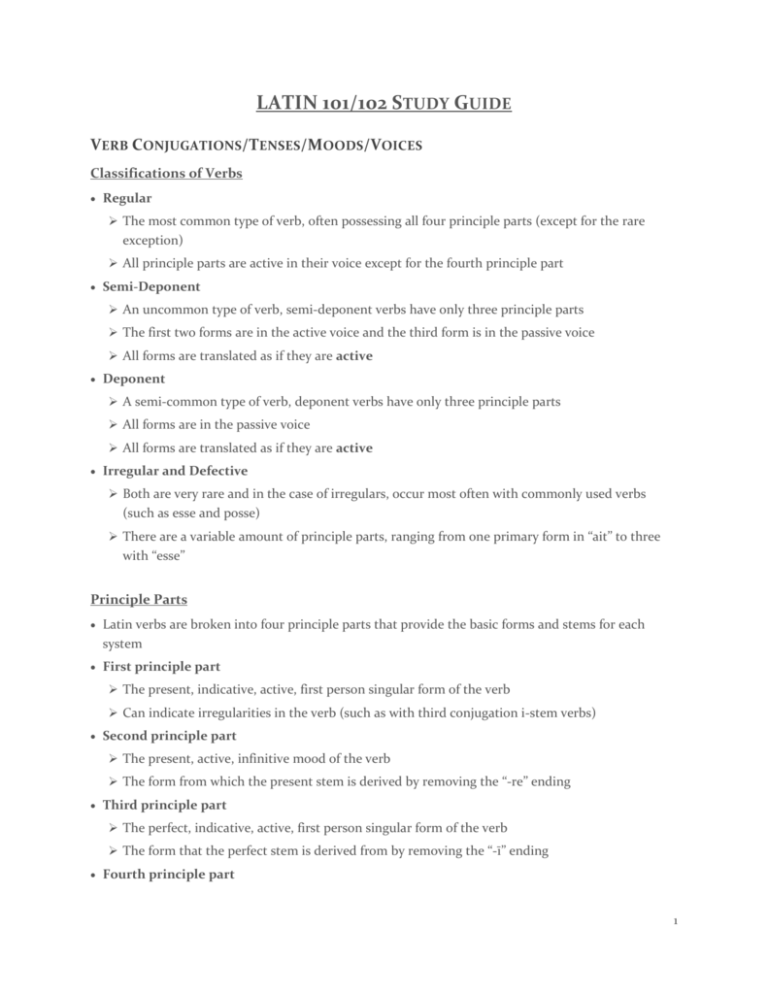
LATIN 101/102 STUDY GUIDE VERB CONJUGATIONS/TENSES/MOODS/VOICES Classifications of Verbs Regular The most common type of verb, often possessing all four principle parts (except for the rare exception) All principle parts are active in their voice except for the fourth principle part Semi-Deponent An uncommon type of verb, semi-deponent verbs have only three principle parts The first two forms are in the active voice and the third form is in the passive voice All forms are translated as if they are active Deponent A semi-common type of verb, deponent verbs have only three principle parts All forms are in the passive voice All forms are translated as if they are active Irregular and Defective Both are very rare and in the case of irregulars, occur most often with commonly used verbs (such as esse and posse) There are a variable amount of principle parts, ranging from one primary form in “ait” to three with “esse” Principle Parts Latin verbs are broken into four principle parts that provide the basic forms and stems for each system First principle part The present, indicative, active, first person singular form of the verb Can indicate irregularities in the verb (such as with third conjugation i-stem verbs) Second principle part The present, active, infinitive mood of the verb The form from which the present stem is derived by removing the “-re” ending Third principle part The perfect, indicative, active, first person singular form of the verb The form that the perfect stem is derived from by removing the “-ī” ending Fourth principle part 1 The perfect, passive, participle form of the verb For regular, semi-deponent, and deponent verbs the ending given is the neuter singular Conjugations First Conjugation (superō, superāre, superāvī, superātum) Marked with an infinitive ending in “-āre” Uses ”-ā” as the linking vowel where appropriate for conjugated forms The third principle part with the exception of dare and stāre ends in “-āvī” The fourth principle part with the exception of dare and stāre ends in “-ātum” Second Conjugation (sedēo, sedēre, sedī, sessum) Marked with an infinitive ending in “-ēre” Uses “-ē” as the linking vowel where appropriate for conjugated forms The third principle part most frequently ends with “-uī” The fourth principle part has no consistent form Third Conjugation (caedō, caedere, cecīdī, caesum) Marked with an infinitive ending in “-ere” Uses “-i” as the linking vowel where appropriate for conjugated forms The third principle part is highly variable with no standardized perfect stem The fourth principle part is also highly variable and regularly changes the stem Third Conjugation i-stem (capiō, capere, cēpī, captum) Marked with an infinitive ending in “-ere” Uses “-i” as the linking vowel where appropriate for conjugated forms; it is irregular in the first person singular and the third person plural, where it is identical to the fourth conjugation The third principle part is highly variable with no standardized perfect stem The fourth principle part frequently takes the first three letters from the present stem Fourth Conjugation (audiō, audīre, audīvī, audītum) Marked with an infinitive ending in “-īre” Uses “-ī” as the linking vowel where appropriate for conjugated forms The third principle part regularly ends in “-īvī” The fourth principle part regularly ends in “-ītum” Tenses Present tense (Present system) The present tense is used to convey action occurring in the present or in the past through use of the historic present, such as during narration 2 There are three potential translations for the present tense: “I love”, “I do love”, and “I am loving” Future tense (Present system) The future tense is used to convey action that will occur but has not yet done so There is one potential translation for the future tense: “I will love” Imperfect tense (Present system) The imperfect tense is used for interrupted action, attempted action, repeated action, and continuous past action (most common usage) There are four potential translations for the imperfect tense “I tried to love”, “I was loving when”, “I have loved (many times)”, and “I have loved” Perfect tense (Perfect system) The perfect tense is used for an action that occurred once in the past (perfect definite) and action in the past that is connected to the present (perfect indefinite) There are two potential translations for the perfect tense: “I loved” (definite) and “I have loved” (indefinite) Future Perfect tense (Perfect system) The future perfect tense is used for an action that will have occurred in the past by a set time There is one potential translation for the future perfect tense: “I will have loved” Pluperfect tense (Perfect system) The pluperfect tense is used for an action that has occurred one step further back than a perfect tense action There is one potential translation for the pluperfect tense: “I had loved” Moods Infinitive mood The infinitive mood is the second principle part of a verb, lacking conjugated forms and most often used as a complementary verb or in an indirect statement There are 6 variants of the infinitive mood, 3 for both the active and passive voices: Present active infinitive (capere), future active infinitive (captūrus, -a, -um esse), perfect active infinitive (cēpisse), present passive infinitive (capī), future passive infinitive (captum īrī), and perfect passive infinitive (captus, -a, -um esse) Indicative mood The indicative mood is used to indicate action that has occurred, is occurring, or will occur 3 Imperative mood The imperative mood is used only for direct commands (directly to the recipient) Subjunctive mood The subjunctive mood is used for actions that are hypothetical and is present in a wide variety of constructions in Latin Voice Active voice The active voice is when the subject of the verb performs the action onto a direct object (I love the girl) Passive voice The passive voice is when the subject becomes the direct object of the performed verb (The girl is loved by me) Participles Participles are half-adjective/noun and half verb Because of this, all participles require case, gender, number, tense, and voice In conjunction with this, participles can take a direct object Participles are always used as auxiliary verbs and in English are often placed into a relative clause All participles are relative when it comes to place in time The present active participle will always occur at the same time as the main verb The future active participle will always occur after the time of the main verb The perfect passive participle will always occur before the time of the main verb Participles have many potential translations which can be grouped under the following categories: Adjectival: The participle is translated as the adjective of a noun (e.g. the loving man) Adversarial: The participle is translated as part of an adversarial relationship (e.g. although) Causal: The participle is translated as part of a causal sequence of events (e.g. because) Relative: The participle is translated to be part of a relative clause (e.g. who) Temporal: The participle is translated as part of a temporal relationship (e.g. when) Present active participle The present active participle is formed by taking the present stem, adding the appropriate linking vowel(s), and then the endings of “-ns” (nominative) and “-ntis” (genitive) The present active participle is treated as a third declension adjective, making it an i-stem noun when declined The present active participle has two ablative forms; If the ending is an “-ī”, it is verbal in nature whereas the form ending in “-e” is used for both adjectival and noun meanings 4 Future active participle The future active participle is formed by taking the fourth principle part of the corresponding verb and replacing “-us, -a, and -um” with “-ūrus, -ūra, and –ūrum” The future active participle is treated as a first and second declension adjective Perfect passive participle The perfect passive participle is formed by using the fourth principle part of the corresponding verb The perfect passive participle is treated as a first and second declension adjective Gerund, Gerundive, and Supine Gerund The gerund is a verbal noun that is active in meaning and can be governed with a preposition The gerund only has oblique cases when declined (all cases excluding the nominative and vocative) Declined forms are made by adding the appropriate linking vowel(s) before “-nd” and then neuter, singular endings after the “-nd” Since the gerund has neither a nominative nor vocative, the infinitive mood of the verb is used The gerund can express purpose when used in the genitive in conjunction with “causā” or “gratiā” Gerundive The gerundive is a verbal adjective/noun that is passive in meaning and can be governed with a preposition Even though the gerundive is passive in meaning, when translated it can be done as if it were active The gerundive is formed in the same manner as the gerund but possesses all of the endings of a first and second declension adjective In the passive periphrastic (gerundive of obligation), the gerundive is combined with a form of “esse” to indicate the need for an action to be done (e.g. the man is to be captured in battle); in this construction, the agent of the action is put into the dative case The gerundive of obligation can also be used impersonally, in the neuter nominative singular form with no subject expressed Supine The supine is a fourth declension, verbal noun found solely in the accusative and ablative cases and is passive in meaning but translated actively The supine is formed by adding “-um” or “-ū” to the perfect passive participle stem The supine is used to form the future, infinitive, passive form of a verb In the accusative case with a verb of motion, the supine is used to indicate purpose 5 The ablative form is rare with the forms “vīsū,” “audītū,” and “dictū” used most often in conjunction with adverbs to express statement (horrībile vīsū!) NOUNS AND ADJECTIVES 6



